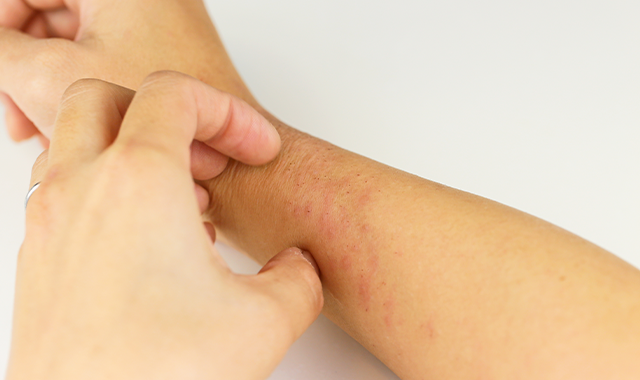- Case-Based Roundtable
- General Dermatology
- Eczema
- Chronic Hand Eczema
- Alopecia
- Aesthetics
- Vitiligo
- COVID-19
- Actinic Keratosis
- Precision Medicine and Biologics
- Rare Disease
- Wound Care
- Rosacea
- Psoriasis
- Psoriatic Arthritis
- Atopic Dermatitis
- Melasma
- NP and PA
- Skin Cancer
- Hidradenitis Suppurativa
- Drug Watch
- Pigmentary Disorders
- Acne
- Pediatric Dermatology
- Practice Management
- Prurigo Nodularis
- Buy-and-Bill
Article
Ocular comorbidities associated with atopic dermatitis
Author(s):
Ocular comorbidity risk is already high in patients with atopic dermatitis and may increase even further as biologic agents are introduced, a study shows.
Ocular comorbidity risk is already high in patients with atopic dermatitis (AD), and may increase even further as biologic agents are introduced, according to authors of new report that includes some of the most extensive epidemiologic data to date on AD-associated ocular disease in adults.
Risks of conjunctivitis, keratitis, and keratoconus were all elevated in AD patients, according to the analysis including more than 10,000 adult AD patients in Danish nationwide registry data, which was recently published in the Journal of the American Academy of Dermatology.
Although the study itself was only designed to quantify current incidence, prevalence, and risk of ocular comorbidities in patients with AD, the authors wrote that the study was prompted in part by âemerging concern about the incidence of conjunctivitis during near-future biologic AD therapy and the possible long-terms consequences thereof.â
The authors cited dupilumab, which had a higher rate of allergic conjunctivitis and conjunctivitis with an unspecified cause in the SOLO 1 and SOLO 2 trials, according to the report published in 2016 in the New England Journal of Medicine.
In addition, the authors said a presentation at the 2016 congress of the European Academy of Dermatology and Venereology showed that there was a âweak trendâ toward more cases of conjunctivitis among adult AD patients treated with the IL-13 inhibitor lebrikizumab as part of the phase 2 TREBLE study.
âThe new biologics for atopic dermatitis are associated with the increased occurrence of conjunctivitis,â lead author Jacob P. Thyssen, M.D., Ph.D. said in an interview with Dermatology Times. âTherefore, these numbers will work very importantly as reference data for future data collections on ocular comorbidities in atopic dermatitis patients treated with biologics.â
Ocular comorbidities are common in AD and are part of the often-cited Hanifin and Rajka3 criteria that describe most diagnostic features associated with the inflammatory skin condition, said Dr. Thyssen, a member of the Department of Dermatology and Allergy at Herlev and Gentofte Hospital, University of Copenhagen, Hellerup, Denmark.
Those criteria were published in 1980. âThat's a time when they made the criteria essentially by putting a hand up and saying, âI suggest this should be part of the syndrome,ââ Dr. Thyssen said. âAnd we actually show now, in real numbers, that these are the complications or comorbidities that our patients experience.â
THE DATA
Dr. Thyssen and colleagues identified a total of 10,038 adults with mild AD (n = 5766) or severe AD (n = 4272) adults in Danish population registry data over the period of Jan. 1, 1997 through Dec. 31, 2012.
The proportion of patients with mild or severe AD who had at least one prescription of anti-inflammatory ocular agents was 12.0% and 18.9%, respectively, according to the report.
After adjusting for age, sex, socioeconomic status, and health care services utilization, an elevated risk of conjunctivitis compared with the general population was observed in the mild AD group (adjusted hazard ratio [HR], 1.48; 95% CI, 1.15-1.90) and the severe AD group (adjusted HR, 1.95; 95% CI, 1.51-2.51), data show.
Keratitis risk was also elevated vs the general population for both the mild AD group (adjusted HR, 1.66; 95% CI, 1.15-2.40) and severe AD group (adjusted HR, 3.17; 95% CI, 2.31-4.35), as was risk of keratoconus in both the mild AD group (adjusted HR, 3.06; 95% CI, 1.21-7.74) and the severe AD group (adjusted HR, 10.01; 95% CI, 5.02-19.96).
In addition, cataracts occurred more frequently in patients with AD who were under 50 years of age, Dr. Thyssen and colleagues reported.
Since the study is observational, it canât establish causality, the authors cautioned.
However, Dr. Thyssen told Dermatology Times that dermatologists need to be vigilant in detecting ocular complications in their patients with AD.
âAfter I really worked with these numbers, I realized that itâs something that I'm neglecting myself to really take into consideration,â he said. âYou tend to focus so much on the skin that you forget to send these patients to the ophthalmologist to have their eyes checked.â
If a patient reports conjunctivitis or worsening of ocular symptoms, then âthe threshold for referral to an ophthalmologist should be lower,â he added.
DISCLOSURES
The authors had no conflicts of interest to declare. Dr. Thyssen is supported by an unrestricted grant from the Lundbeck Foundation, has attended an advisory board for Roche and Sanofi-Genzyme, and has been a speaker on atopic dermatitis for LEO Pharma.
REFERENCES
Thyssen JP, Toft PB, Halling-Overgaard A-S, Gislason GH, Skov L, Egeberg A. âIncidence, prevalence, and risk of selected ocular disease in adults with atopic dermatitis,â Journal of the American Academy of Dermatology. August 2017. DOI: http://dx.doi.org/10.1016/j.jaad.2017.03.003
Simpson EL, Bieber T, Guttman-Yassky E, et al. âTwo Phase 3 Trials of Dupilumab versus Placebo in Atopic Dermatitis,â New England Journal of Medicine. Dec. 15, 2016. DOI: 10.1056/NEJMoa1610020
Hanifin J, Rajka G. âDiagnostic features of atopic dermatitis,â Acta Dermato Venereologica.






